
The summer is drawing to a close and many of us are now looking forward to an October week or winter-sun retreat. Sunny sport climbing is a popular way to beat the UK winter blues, with the number of world-wide destinations growing year upon year. The prospect of a week or two climbing abroad with friends, in the sun (hopefully) with a plentiful supply of foreign rock is very appealing, and this article gives some suggestions for places to go, and some tips to help less experienced climbers get the most out of their Easyjet extravaganza.
Choosing the right destination, crags, routes, equipment and knowing what to expect from the trip and from yourself can mean the difference between an ok week and a brilliant week. Here are some tips to make that sport trip one to remember - and for all the right reasons.
Choose an appropriate destination!
It's your first experience of a sport climbing holiday abroad. These days, the World is your oyster and sport climbing destinations are cropping up all over the globe. It's tempting to travel far and try out an exotic new location, but if you're looking for milage on the rock as opposed to a travel experience then we would suggest somewhere with a reputation for easy access cliffs, quality lower grade routes and surroundings which match your idea of a holiday. Well-established areas in hotspots like Spain and France will obviously have plentiful information available, so bear this in mind for your first trip. Jungle bashing in Madagascar might look exciting, and it is, but you'll get more routes ticked in El Chorro!
Some good suggestions (with UKC Destination Guides linked) for a first-timer would be:
WINTER:
- Kalymnos (An amazing Greek island, avoid in the heat of summer if possible, busy in October)
- El Chorro (the classic winter-sun destination near Malaga, Spain again too hot in summer)
- Costa Blanca - Sella or Calpe (a good springtime/Easter option, or for winter-sun)
-
La Turbie , Toulon Area, Mont Coudon, Baou de Quatre Ouro and Mont Faron - All can be done from flights to Nice
- Geyik Bayiri (a brilliant Turkish destination that is rapidly growing in popularity.)
SUMMER:
- Céuse (A higher-end destination with grades above 7a but there is a selection of quality easier routes if you don't mind an hour's walk-in. Good if you are travelling with a mixed ability group)
- Finale Ligure/Val Pennavaire (A mix of old-school and modern sport climbs, with a good variety of shaded crags and other activities to cool-off on hot days or post-climbing)
SPRING/AUTUMN:
- Mallorca (good if you're looking for some beach time too, perhaps not quite as dry as mainland Spain)
- Orpierre (set in a quaint French village with good easy routes - excellent in Spring and Autumn)
- Orgon and Aurielle (TGV to Avignon and can be done without a car!)
- Ubrieux - Rocher de Saint-Julien - Les Dentelles (Buis Les Baronnies Area)
- Calamès and Auzat (Ariege - very quiet but with surprisingly good climbing)
- Siurana (renowned for its harder routes but with a good variety of easier crags too that often get overlooked and are rarely teaming with people..)
Sport crags can unfortunately be very busy places - maybe this is something you're looking for on a first trip, to meet new people and learn from other climbers. If not, escaping the crowds can be possible if you do some research.
Choose the destination according to the season - for example, climbing in the height of summer in Greece might not be the best idea for a sun-lacking Brit, whereas Easter or October - although peak season - will provide more amenable conditions. To enjoy quieter crags, a compromise might have to be made by booking for an off-peak time with slightly hotter conditions. Check guidebooks and weather reports for information on when to go and when to avoid.
Whilst the coolest-looking crags might be steep, long and imposing, go for an area with shorter, easier-graded routes on gentle angles to ease yourself into the climbing, especially if you have little experience of climbing outdoors generally.
Choose your companions wisely...
Harsh as it sounds, if you're looking to have an enjoyable time and maybe push yourself a little further out of your home comfort zone then you need to consider who you'll be climbing with. Many people heading out for their first sport trip will do so in a large social group, which makes for great fun and a range of potential partners. However, the downside to this is that different members of the group will likely have different ambitions for the holiday and different ability levels.
If you're keen to redpoint a particular route or grade, having a partner or group that just want to climb one route then head to the beach won't make for a fantastic trip for you. Equally, if you're just out to have fun whilst your friends enter robo-redpoint mode and shut-off from the rest of the world entirely on an obscure crash-diet...well, you get the point.
Within the group, try and split up into pairs or teams of like-minded people who have similar aims for the trip. It is worth getting this sorted before you go to avoid confusion or lack of partners when you arrive at your holiday hotspot.
Projecting a climb together with another person can be a ticket to success - two minds are better than one and sharing beta (information) on moves can be really helpful. Different sectors may be better suited to higher grades, some to lower grades, so you might be best not to spend the entire trip climbing as a large group (for your sanity and for the health of your friendships, if nothing else!)
Get your kit sorted before you go
This may seem fairly obvious and self-explanatory, but some key questions you have to ask yourself are: "Do I have enough quickdraws?", "Is my rope long enough?" One point which is especially important when travelling and teaming up with others is deciding who will take what, and working out exactly what you have. There's no point taking one set of 12 quickdraws between you if your mate plans on a redpoint siege - if they get left hanging in a route for the whole week, what will you use? Ideally, have a set of quickdraws each or at least one set between each pair. Check guidebooks for information on local gear shops in case of emergency.
Ensure that you check route lengths in the guidebook to be sure your rope is long enough. Some people forget that the rope length has to be at the very least double the length of the climb. What goes up, must come back down - safely.
Keep a knot in the end of the rope and an eye on both your partner and how much rope you have left.
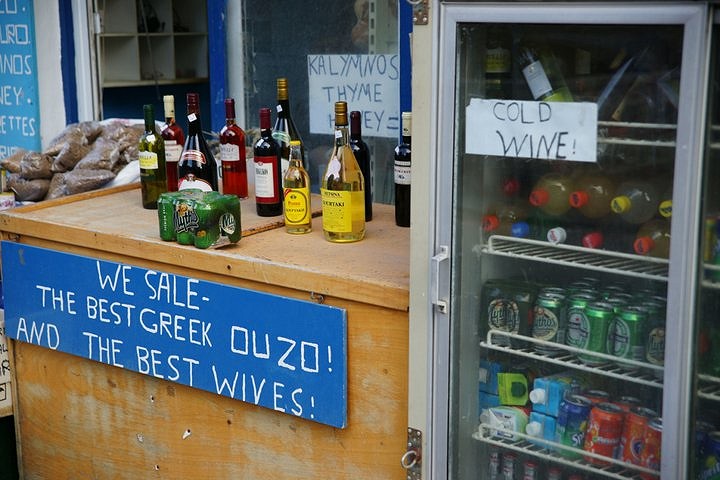
If you're borrowing equipment from others, make sure it's in good condition and that they can tell you how old it is. And make sure you know how long their rope is before you get stuck 10m off the deck! A helmet is always a good idea but many climbers don't wear one when single pitch sport climbing. Helmet or no helmet, the usual rule applies: don't stand underneath climbers if you can help it - they can drop rocks, carabiners and all sorts!
Learn to re-thread a belay before you're 30m in the air...
Having to re-thread the belay for the first time whilst dangling 30m off the deck can be a bit airy... It may not be necessary if there are in-situ screwgates in the chains, but it's an essential sport climbing skill that you need to learn BEFORE you find yourself at the top of a route! Get an experienced friend or instructor to guide you through it before you leave and practice on the ground before doing it for real 30 metres up a cliff. No matter how often you've re-threaded, accidents can and do happen. There's no room for complacency - check and double check, triple check even, and never rush into it if you're feeling tired after a climb. Stop, rest on the rope and wait until the summit fever and fatigue resides before re-threading.
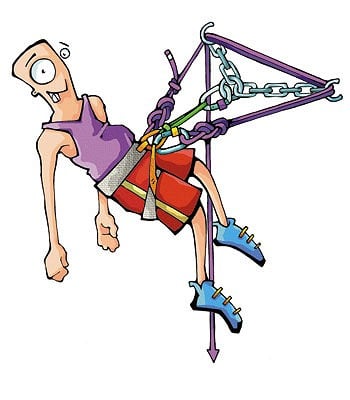
If you plan on top-roping a route, try to put the rope through two of your own quickdraws at the top, rather than letting the rope run through the in-situ screwgate. This reduces wear-and-tear on the in-situ gear.
Check out this UKC article on re-threading.
Pace yourself!
You've arrived. It's so exciting! You've already Facebooked and Instagrammed your social circle and friends back home are seething with jealousy, but don't burn yourself out after the first day or so! It happens so often - the Keen Bean of the group heads out and tries to tick every route at the crag, before jumping onto a redpoint project straight away. Their enthusiasm is admirable, but they never last long (unless they're a super-wad!).
Climbing in a new country, in a new environment and in different conditions to the UK takes a bit of getting used to. You've probably travelled out, not slept too great the night before and your body is adjusting to a change of routine - not to mention the sweltering heat (if you're lucky). Take it easy - warm up slowly and get a feel for the rock, you'll likely not have climbed on limestone or other new rocktypes much before and the bulging features and flowing tufas might be a little intimidating at first. Reading sequences on strange new rock is tricky, and you'll spend longer hanging around, even on routes below your limit.
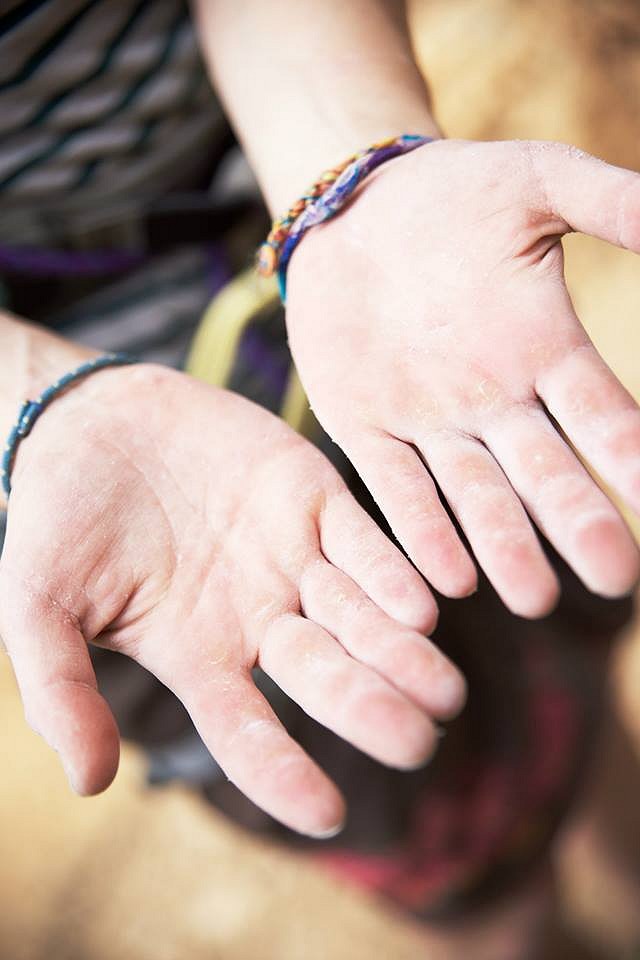
Forcing yourself onto a route at your limit on the first day will tire you, possibly intimidate you and set you back for the rest of the trip. Remember that grades at indoor walls don't necessarily translate well onto rock, so don't expect to climb at your indoor max grade straight away!
Pick your routes carefully and move around
Once again the objectives of a trip vary from person to person, and are very much determined by the length of time you have. If a short week-long holiday of quick ticks is what you're after, then playing to your strengths is the obvious option. On your first trip abroad, you're unlikely to have had much experience of more obscure rock formations like tufas, so whilst it's fun to experience them on lower-grade routes, picking a project which requires a bit more technique and experience to get up them might not be your best bet. If you're somewhere like Kalymnos, then tough - you might just have to get on with it! That said, there will likely be some routes more suitable than others.
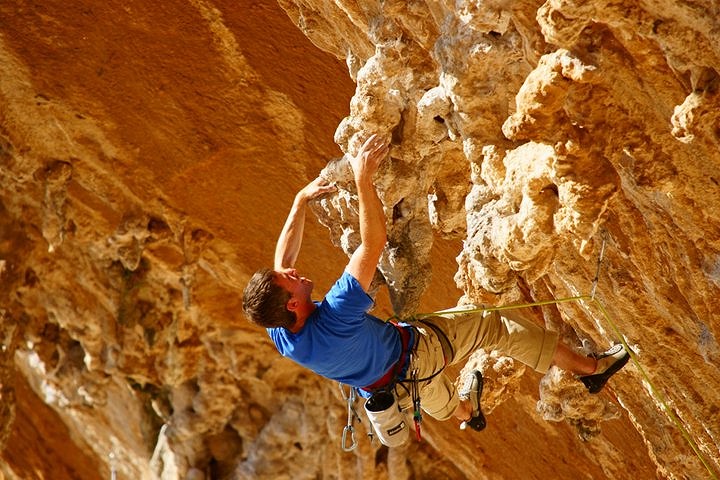
Have a look in the guidebook at the star-rating and at the comments in UKC logbooks if you want to know what a route's really like (beware of skewed perceptions - people tend to rate routes they find hard less highly than the routes they find easy...) Routes with one or more stars will usually be worth a punt, although routes with 3 stars might get a lot of traffic so you can expect a bit of 'polish' or slippy rock from rubber shoes. Some people love to study guidebooks for hours on end before a trip and have a ticklist of routes to try; others are less goal-oriented, but it will speed things up if you have a few routes to aim for rather than being overwhelmed by the array of routes on offer when you arrive.
If you're struggling to get to grips with one sector in particular, move around to another one which may suit your style better. It's easy to stay within your comfort zone and stick to familiar surroundings, but don't be scared to try another sector or area if it's at all possible - you might find the perfect route for you! On a longer trip, you can afford the luxury of trying routes that aren't really your style - it's not pleasant to get shut down on a climb, but your climbing will thank you for it if you take the time to learn something new.
Time your climbing sessions sensibly
As Brits, we tend to seek-out the sun. On climbing trips, the story is the same. Some people do enjoy climbing in the full heat of the sun, earning their annual requirement of vitamin D in one hit. There's nothing wrong with climbing in the sun, but if you want to, make sure you are prepared for it. Wear sunscreen, a hat and glasses, particularly if you burn easily. Nobody wants to be the lobster of the crag...
On the other hand, redpointing or onsighting routes at your limit in full or evening sun can increase the difficulty by a considerable margin. You're hot, sweaty and you can barely see the holds! Work out when your chosen crag gets the sun - the guidebook will usually provide this information - and try and avoid these times. Early morning or late afternoon climbing can be very pleasant indeed, particularly if combined with an afternoon or morning of rest.
Fear of failing and fear of failure - don't let them spoil your holiday!
Falling off outdoors feels different to indoors, and even if you've never thought twice of taking a whipper at the wall, you might find it's a different experience altogether on rock. If you're feeling anxious about leading during the trip, try top-roping some easier climbs to build up your confidence, taking small falls as you let go and weight the rope (see point about top-roping on in-situ gear). It's not a nice thought to have spent money and travelled to somewhere to be limited by your head - you might have put hours of physical preparation in, but if you leave your head behind at the wall back home then progressing on holiday will be tricky.
Fear of falling is a complex mental issue, but the first step is being aware that it can and probably will affect you - many people will be surprised at their fear or struggle to accept it, so acknowledging that it might rear its ugly head in the first place will mean less frustration when you travel to your destination. Ensure that you have an experienced belayer who you trust and functional gear that you have checked is safe (as above) - if you have any doubts about the capabilities of your belayer or gear, then your performance won't be at its best.
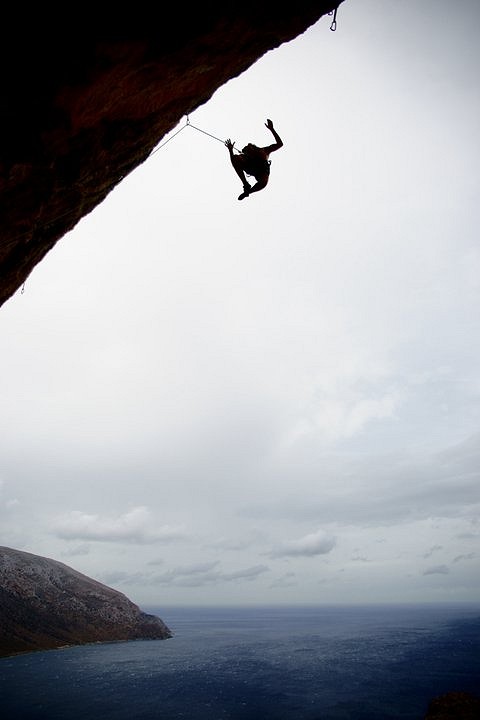
If you're battling with a fear of falling, start off on easy ground and build up. Falling off is generally more pleasant on slightly steeper ground, so even though that overhanging route might look intimidating on first sight, when you get on it you could feel surprisingly more comfortable than you did on that ploddy slab...
Another element to consider is performance pressure. You were so excited about this trip. You saved up loads of money, took time off work, maybe you trained really hard too for a specific goal. But the reality of sport climbing holidays - just like holidays in general - is that they don't always live up to expectations. Don't let an arbitrary path up a piece of rock spoil the experience - a climbing goal shouldn't define your holiday, as much as you like to think it does. It's a bitter pill to swallow, but the climbs you succeed on are just the icing on the cake - the places you see, the people you meet and the effort you put into the holiday will probably outlive the memory of clipping the chains!
Above all, relax, have fun and start planning the next one!
- SKILLS: Top Tips for Learning to Sport Climb Outdoors 22 Apr
- INTERVIEW: Albert Ok - The Speed Climbing Coach with a Global Athlete Team 17 Apr
- SKILLS: Top 10 Tips for Making the Move from Indoor to Outdoor Bouldering 24 Jan
- ARTICLE: International Mountain Day 2023 - Mountains & Climate Science at COP28 11 Dec, 2023
- ARTICLE: Did Downclimbing Apes help Evolve our Ultra-Mobile Human Arms? 5 Dec, 2023
- ARTICLE: Dàna - Scotland's Wild Places: Scottish Climbing on the BBC 10 Nov, 2023
- INTERVIEW: Loki's Mischief: Leo Houlding on his Return to Mount Asgard 23 Oct, 2023
- INTERVIEW: BMC CEO Paul Davies on GB Climbing 24 Aug, 2023
- ARTICLE: Paris 2024 Olympic Games: Sport Climbing Qualification and Scoring Explainer 26 Jul, 2023
- INTERVIEW: Malcolm Bass on Life after Stroke 8 Jun, 2023




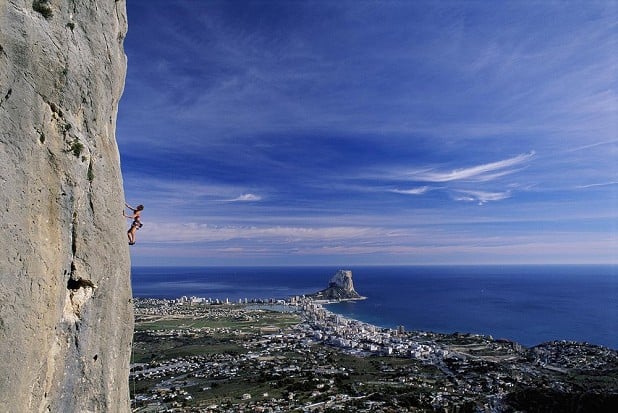
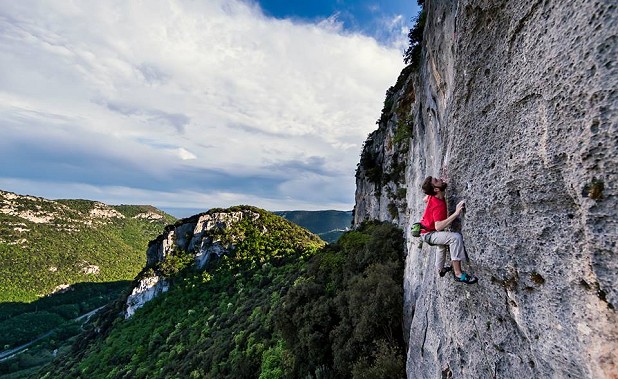

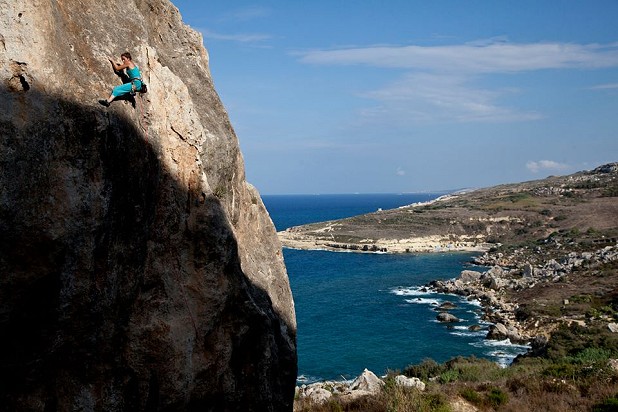
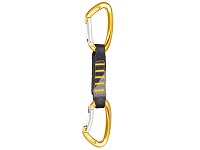

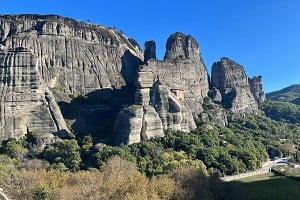
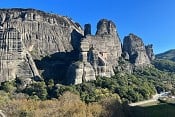










Comments